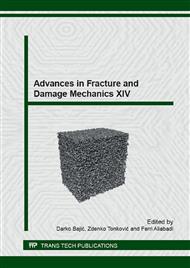p.113
p.117
p.121
p.125
p.129
p.133
p.137
p.141
p.145
Mechanical and Fatigue Parameters of Two Types of Alkali-Activated Concrete
Abstract:
The alkali-activated concrete is prepared as a new potential material for the production of concrete elements developed by ZPSV, a. s. company. Note that civil engineering structures are usually made of ordinary Portland cement (OPC) based concrete but today, the cement industry is responsible for emitting between 6% and 7% of all the CO2 emission into the atmosphere. Therefore, it is essential to seek different binders to provide environmental friendly materials. One possible alternative is the application of alkali-activated concrete. The optimal design of concrete mixture was studied in this investigation. Two types of concrete have a similar application and therefore the fatigue parameters can be compared. To this aim, specimens were prepared and tested under static (compressive cube strength) and cyclic loading (fatigue parameters − Wöhler curve). The experimentally obtained results (both mechanical and fatigue) of both types of concrete are compared and the suitability of these types of composites for its application is discussed.
Info:
Periodical:
Pages:
129-132
Citation:
Online since:
September 2015
Authors:
Price:
Сopyright:
© 2016 Trans Tech Publications Ltd. All Rights Reserved
Share:
Citation:


